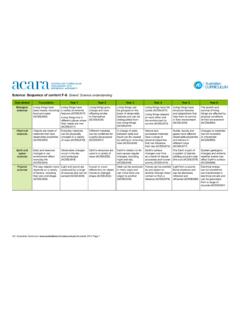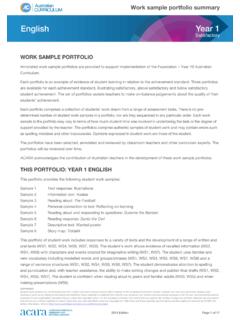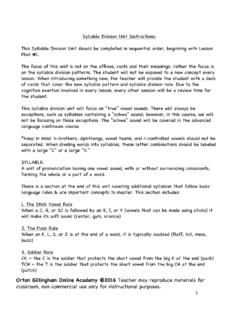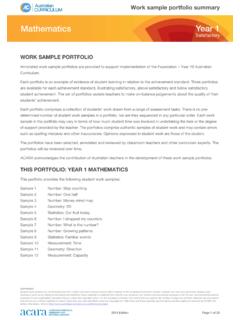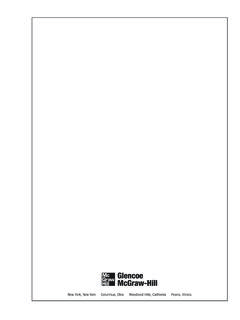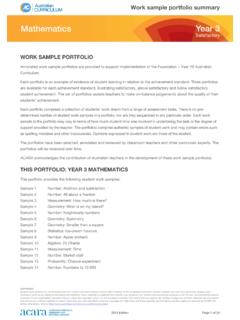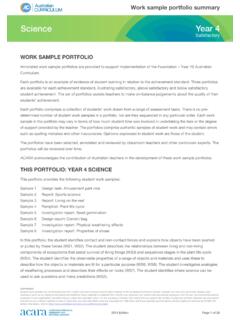Transcription of athematics Year 5 - docs.acara.edu.au
1 MathematicsYear 5 Satisfactory2014 EditionPage 1 of 32 Work sample portfolio summaryWORK SAMPLE PORTFOLIOA nnotated work sample portfolios are provided to support implementation of the Foundation Year 10 Australian portfolio is an example of evidence of student learning in relation to the achievement standard. Three portfolios are available for each achievement standard, illustrating satisfactory, above satisfactory and below satisfactory student achievement. The set of portfolios assists teachers to make on-balance judgements about the quality of their students portfolio comprises a collection of students work drawn from a range of assessment tasks. There is no pre-determined number of student work samples in a portfolio, nor are they sequenced in any particular order. Each work sample in the portfolio may vary in terms of how much student time was involved in undertaking the task or the degree of support provided by the teacher.
2 The portfolios comprise authentic samples of student work and may contain errors such as spelling mistakes and other inaccuracies. Opinions expressed in student work are those of the portfolios have been selected, annotated and reviewed by classroom teachers and other curriculum experts. The portfolios will be reviewed over time. ACARA acknowledges the contribution of Australian teachers in the development of these work sample portfolios. THIS PORTFOLIO: YEAR 5 MATHEMATICSThis portfolio provides the following student work samples: Sample 1 Geometry: My angle Sample 2 Measurement: Garden bed Sample 3 Number: Treasure hunt Sample 4 Measurement: How many can you make? Sample 5 Number: Who are the fastest swimmers? Sample 6 Measurement: Using time Sample 7 Measurement: Using perimeter and area Sample 8 Geometry: Location and transformation Sample 9 Number: Number sentences Sample 10 Geometry: Mapping Sample 11 Statistics and Probability: Come in spinner Sample 12 Number: How do I check my work?
3 Sample 13 Number: Spring fair COPYRIGHTS tudent work samples are not licensed under the creative commons license used for other material on the Australian Curriculum website. Instead, you may view, download, display, print, reproduce (such as by making photocopies) and distribute these materials in unaltered form only for your personal, non-commercial educational purposes or for the non-commercial educational purposes of your organisation, provided that you retain this copyright notice. For the avoidance of doubt, this means that you cannot edit, modify or adapt any of these materials and you cannot sub-license any of these materials to others. Apart from any uses permitted under the Copyright Act 1968 (Cth), and those explicitly granted above, all other rights are reserved by ACARA. For further information, refer to ( ).
4 MathematicsYear 5 Satisfactory2014 EditionPage 2 of 32 This portfolio of student work shows the measurement and construction of different angles (WS1), comparison of the sizes of fractions by diagrams and calculations and their representation on a number line (WS2, WS5). The student solves problems using the four operations (WS3, WS9) and explains how they know their answers to calculations are reasonable (WS12). The student makes spinners to assist in carrying out simple probability experiments before evaluating the results (WS11) and creates a simple budget (WS13). The student investigates the areas and perimeters of different rectangles (WS7). The student explains the effect of transformations (WS8), locates axes of symmetry of shapes and describes the features of three-dimensional objects using two-dimensional representations (WS4).
5 The student creates maps, locates landmarks and describes directions to locations (WS10). The student converts between 12 and 24 hour time (WS6). Work sample portfolio summaryCOPYRIGHTS tudent work samples are not licensed under the creative commons license used for other material on the Australian Curriculum website. Instead, you may view, download, display, print, reproduce (such as by making photocopies) and distribute these materials in unaltered form only for your personal, non-commercial educational purposes or for the non-commercial educational purposes of your organisation, provided that you retain this copyright notice. For the avoidance of doubt, this means that you cannot edit, modify or adapt any of these materials and you cannot sub-license any of these materials to others. Apart from any uses permitted under the Copyright Act 1968 (Cth), and those explicitly granted above, all other rights are reserved by ACARA.
6 For further information, refer to ( ).MathematicsYear 5 SatisfactoryWork sample 12014 EditionPage 3 of 32 Geometry: My angleYear 5 Mathematics achievement standardThe parts of the achievement standard targeted in the assessment task are highlighted. By the end of Year 5, students solve simple problems involving the four operations using a range of strategies. They check the reasonableness of answers using estimation and rounding. Students identify and describe factors and multiples. They explain plans for simple budgets. Students connect three-dimensional objects with their two-dimensional representations. They describe transformations of two-dimensional shapes and identify line and rotational symmetry. Students compare and interpret different data order decimals and unit fractions and locate them on number lines.
7 They add and subtract fractions with the same denominator. Students continue patterns by adding and subtracting fractions and decimals. They find unknown quantities in number sentences. They use appropriate units of measurement for length, area, volume, capacity and mass, and calculate perimeter and area of rectangles. They convert between 12 and 24 hour time. Students use a grid reference system to locate landmarks. They measure and construct different angles. Students list outcomes of chance experiments with equally likely outcomes and assign probabilities between 0 and 1. Students pose questions to gather data, and construct data displays appropriate for the of taskStudents had completed a unit of work on angles and their properties. They were given the following problems to solve: Can you estimate and draw an angle of approximately 135 without using a protractor?
8 I looked at the clock before school and noticed that the hands made an acute angle. What time could it be? I looked at the clock before school and noticed that the hands made a right angle. What time could it be? How do you know that you are right? I looked at the clock before school and noticed that the hands made a reflex angle. What time could it be? How do you know that you are right?MathematicsWork sample 1 Year 5 Satisfactory2014 EditionPage 4 of 32 CopyrightStudent work samples are not licensed under the creative commons license used for other material on the Australian Curriculum website. Instead, a more restrictive licence applies. For more information, please see the first page of this set of work samples and the copyright notice on the Australian Curriculum website ( ).AnnotationsEstimates and constructs an angles using angles with a angles in real-life : My angleMathematicsYear 5 Satisfactory2014 EditionPage 5 of 32 Measurement: Garden bedYear 5 Mathematics achievement standardThe parts of the achievement standard targeted in the assessment task are highlighted.
9 By the end of Year 5, students solve simple problems involving the four operations using a range of strategies. They check the reasonableness of answers using estimation and rounding. Students identify and describe factors and multiples. They explain plans for simple budgets. Students connect three-dimensional objects with their two-dimensional representations. They describe transformations of two-dimensional shapes and identify line and rotational symmetry. Students compare and interpret different data order decimals and unit fractions and locate them on number lines. They add and subtract fractions with the same denominator. Students continue patterns by adding and subtracting fractions and decimals. They find unknown quantities in number sentences. They use appropriate units of measurement for length, area, volume, capacity and mass, and calculate perimeter and area of rectangles.
10 They convert between 12 and 24 hour time. Students use a grid reference system to locate landmarks. They measure and construct different angles. Students list outcomes of chance experiments with equally likely outcomes and assign probabilities between 0 and 1. Students pose questions to gather data, and construct data displays appropriate for the of taskStudents had completed a unit of work on fractions and decimals. They were asked to complete two tasks: Divide a large rectangular garden bed into a number of equal plots. What addition and subtraction sentences can you create with fractions by looking at your garden? Tom created a number pattern which included the decimal What could the pattern be?Work sample 2 MathematicsYear 5 Satisfactory2014 EditionPage 6 of 32 CopyrightStudent work samples are not licensed under the creative commons license used for other material on the Australian Curriculum website.





